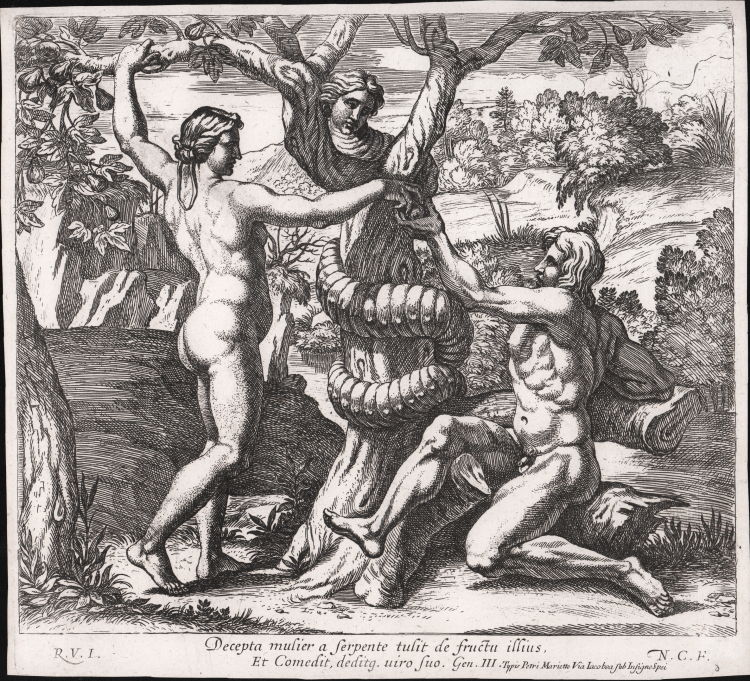




| Reference: | S45550 |
| Author | Nicolas CHAPERON |
| Year: | 1649 |
| Measures: | 255 x 235 mm |



| Reference: | S45550 |
| Author | Nicolas CHAPERON |
| Year: | 1649 |
| Measures: | 255 x 235 mm |
Decepta mulier a serpente tulit de fructu illius, et Comedit, deditg. viro suo.
Etching, from a subject d Raphael. From the series Sacrae Historiae Acta a Raphael Urbin in Vaticanis Xystis ad Picturae Miraculum Expressa.
Example in the third state of four, with the address of Pierre Mariette.
The series 'Sacrae Historiae Acta a Raphael Urbin in Vaticanis Xystis ad Picturae Miraculum Expressa' reproduces the complete series of frescoes painted by Raphael in the Logge. It consists of 54 plates: a dedication to Raphael, a title-page with a dedicatory text to Renard, and fifty-two plates reproducing Raphael's frescoes. The dedication and the title-page are not numbered, while the plates reproducing the frescos are numbered from 1 to 52. The series was engraved by Nicolas Chaperon and published in Rome in 1649.
The series of frescoes in the Logge, also known as Raphael's Bible, has been widely reproduced throughout the 17th century: Badalocchio and Lanfranco in 1605/06, Aloisi Galanini in 1613, Borgianni in 1615, Villamena in 1626, Aquila and Fantetti in 1675.
One of Simon Vouet's best pupils, Nicolas Chaperon moved to Rome in 1642 and joined the classicist style of Nicolas Poussin. It was the latter painter who, through the commission he received from the king of France, commissioned from him the 54 engraved plates depicting Raphael's most famous paintings. Four are known to have been presented with two frontispieces (as per tradition therefore 52 reproducing the paintings and two frontispieces): the rarest one presents in the frontispiece the words Ille ego sum Raphael and the second plate without the dedication, the second has the dedication and the addition cum Privilegio Regis, the third with the addition in the cippus present in the frontispiece Lutetiae Parisiorum and with the excudit of Mariette, finally the fourth retouched and published between the seventeenth and eighteenth centuries.
Each plate is doubly signed, R.V.I. or Raphael Urbinas Invenit and N.C.F. equivalent of Nicolas Chaperon Fecit. The plates are from the date of their execution considered the most faithful to the frescoes and the closest to the classical taste in vogue in those years between Rome and Paris.
Etching impressed on contemporary laid paper, trimmed to copper or thin margin, in very good condition.
Bibliografia
Robert-Dumesnil 1835-71, Le Peintre-Graveur Français (VI.216.1); Laveyssière, Jacquot and Kazerouni, 'Nicolas Chaperon', 1999, pp.159-171.
Nicolas CHAPERON (Châteaudun 1612 - Lyon 1656)
|
Nicolas Chaperon (bapt. 19 October 1612, in Châteaudun – 1656 in Lyon) was a French painter, draughtsman and engraver, a student in Paris of Simon Vouet whose style he adopted before he was further matured by his stay in Rome (1642–51) in the studio of Nicolas Poussin.
Nicolas Chaperon was ranked by Pierre-Jean Mariette among Simon Vouet's most accomplished pupils. After completing his apprenticeship in Vouet's large Paris workshop, Chaperon was seduced by the refined classicism of Nicolas Poussin, whom he may have met in Paris and certainly knew in Rome. In around 1640-2, Chaperon travelled to Rome where he worked under Poussin for François Sublet de Noyers in the Galleria Farnese. Chaperon's technique was so indebted to Poussin that paintings by the former, such as his Nurture of Jupiter (Ackland Art Museum, Chapel Hill, NC; fig. 1), were engraved as works by Poussin as late as the nineteenth century. Their professional relationship in Rome was short-lived, and by 1644 Chaperon was documented in Malta, possibly as a result of a dispute with the master. In 1649 Chaperon returned to Rome, where he published a series of engravings after Raphael's frescoes in the Vatican Loggie, generally considered the finest engravings after the celebrated cycle. Chaperon, like Poussin, would spend his final years in Rome, never returning to his native country.
|
Nicolas CHAPERON (Châteaudun 1612 - Lyon 1656)
|
Nicolas Chaperon (bapt. 19 October 1612, in Châteaudun – 1656 in Lyon) was a French painter, draughtsman and engraver, a student in Paris of Simon Vouet whose style he adopted before he was further matured by his stay in Rome (1642–51) in the studio of Nicolas Poussin.
Nicolas Chaperon was ranked by Pierre-Jean Mariette among Simon Vouet's most accomplished pupils. After completing his apprenticeship in Vouet's large Paris workshop, Chaperon was seduced by the refined classicism of Nicolas Poussin, whom he may have met in Paris and certainly knew in Rome. In around 1640-2, Chaperon travelled to Rome where he worked under Poussin for François Sublet de Noyers in the Galleria Farnese. Chaperon's technique was so indebted to Poussin that paintings by the former, such as his Nurture of Jupiter (Ackland Art Museum, Chapel Hill, NC; fig. 1), were engraved as works by Poussin as late as the nineteenth century. Their professional relationship in Rome was short-lived, and by 1644 Chaperon was documented in Malta, possibly as a result of a dispute with the master. In 1649 Chaperon returned to Rome, where he published a series of engravings after Raphael's frescoes in the Vatican Loggie, generally considered the finest engravings after the celebrated cycle. Chaperon, like Poussin, would spend his final years in Rome, never returning to his native country.
|